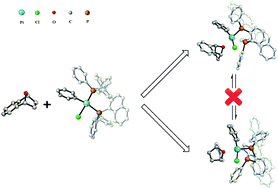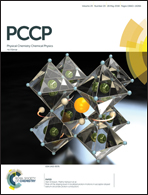Study on the mechanism of platinum(ii)-catalyzed asymmetric ring-opening addition of oxabicyclic alkenes with arylboronic acids†
Abstract
The mechanism of an asymmetric ring-opening (ARO) addition of oxabicyclic alkenes catalyzed by a platinum(II) catalyst was investigated by M06-2X/6-311G(d,p) using density functional theory (DFT). All the structures were optimized in the solvent model density (SMD) solvation model (solvation = the mixture of H2O/CH2Cl2 1 : 10, v/v) for consistence with experimental conditions. The overall mechanism is considered as a four-step reaction including transmetalation, carboplatinum, β-oxygen elimination, and hydrolysis. The transmetalation and carboplatinum steps are multi-step processes, and both the regioselectivity and the enantioselectivity lie in the carboplatinum process. Based on the natural population analysis (NPA) and the orbital composition analysis of oxabicyclic alkenes, the preferable coordination site with a platinum(II) center is considered as the bridging oxygen atom by exo-coordination because of the less steric hindrance and the stronger electronic effect. This coordination is thought of as origin of the regioselectivity and the enantioselectivity, which is different from that proposed previously. The Gibbs free energy profiles show that the rate-determining step involves the migration of an aryl group from the platinum(II) center to one of the closer enantiotopic carbon atoms in an alkene of the oxabicyclic alkenes. The theoretically predicted enantiomeric excess (ee) value of 82% for this reaction is very close to the experimental ee value of 80%. It was found that the hydrogen bonds between the oxabicyclic alkenes and water molecules promotes the platinum(II) catalyst leaving the reaction system effortlessly and entering the next catalysis recycle. In the overall catalytic cycle, the highest free energy barrier is 30.1 kcal mol−1 and the process releases an energy of 26.3 kcal mol−1. The results confirm that the Pt(II)-catalyzed ARO reactions take place at mild experimental conditions, which is consistent with the experiment observations. Thus, this study is important for understanding the catalytic behavior of the transition metal platinum(II) in an asymmetric ring-opening reaction.



 Please wait while we load your content...
Please wait while we load your content...